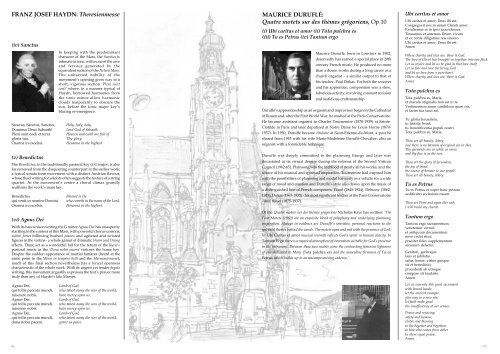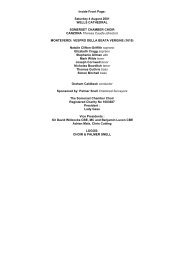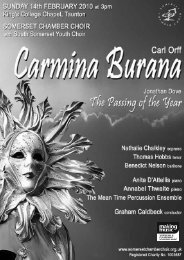to view the concert programme - Somerset Chamber Choir
to view the concert programme - Somerset Chamber Choir
to view the concert programme - Somerset Chamber Choir
You also want an ePaper? Increase the reach of your titles
YUMPU automatically turns print PDFs into web optimized ePapers that Google loves.
FRANZ JOSEF HAYDN: Theresienmesse<br />
(iv) Sanctus<br />
Sanctus, Sanctus, Sanctus,<br />
Dominus Deus Sabaoth!<br />
Pleni sunt coeli et terra<br />
gloria tua.<br />
Osanna in excelsis.<br />
(v) Benedictus<br />
In keeping with <strong>the</strong> predominant<br />
character of <strong>the</strong> Mass, <strong>the</strong> Sanctus is<br />
intimate in <strong>to</strong>ne, with none of <strong>the</strong> awe<br />
and fervour generated by <strong>the</strong><br />
equivalent section of <strong>the</strong> Nelson Mass.<br />
The unhurried nobility of <strong>the</strong><br />
movement’s opening gives way <strong>to</strong> a<br />
short, vigorous section ‘Pleni sunt<br />
coeli’ where, in a manner typical of<br />
Haydn, borrowed harmonies from<br />
<strong>the</strong> <strong>to</strong>nic minor allow harmonic<br />
clouds temporarily <strong>to</strong> obscure <strong>the</strong><br />
sun, before <strong>the</strong> <strong>to</strong>nic major key’s<br />
blazing re-emergence.<br />
Holy, holy, holy,<br />
Lord God of Sabaoth.<br />
Heaven and earth are full of<br />
Thy glory.<br />
Hosanna in <strong>the</strong> highest.<br />
The Benedictus, in <strong>the</strong> traditionally pas<strong>to</strong>ral key of G major, is also<br />
far removed from <strong>the</strong> disquieting counterpart in <strong>the</strong> earlier work;<br />
a lyrical sonata-form movement with a distinct Austrian flavour,<br />
whose fluid writing for soloists often suggests <strong>the</strong> texture of a string<br />
quartet. At <strong>the</strong> movement’s centre a choral climax grandly<br />
reaffirms <strong>the</strong> work’s main key.<br />
Benedictus<br />
qui venit in nomine Domini.<br />
Osanna in excelsis.<br />
(vi) Agnus Dei<br />
Blessed is He<br />
who cometh in <strong>the</strong> name of <strong>the</strong> Lord.<br />
Hosanna in <strong>the</strong> highest.<br />
With its bare unison writing <strong>the</strong> G minorAgnus Dei has an asperity<br />
startling in <strong>the</strong> context of this Mass, with powerful chorus unisons,<br />
subi<strong>to</strong> fortes following hushed pianos and agitated and twisted<br />
figures in <strong>the</strong> violins - a whole gamut of dramaticSturm und Drang<br />
effects. These act as a wonderful foil for <strong>the</strong> return of <strong>the</strong> Kyrie’s<br />
pas<strong>to</strong>ral music as <strong>the</strong> ‘Dona nobis pacem’ res<strong>to</strong>res <strong>the</strong> home key.<br />
Despite <strong>the</strong> sudden appearance of martial fanfares (heard at <strong>the</strong><br />
same point in <strong>the</strong> Missa in tempore belli and <strong>the</strong> Harmoniemesse),<br />
much of this final section never<strong>the</strong>less has a lyrical openness<br />
characteristic of <strong>the</strong> whole work. With its urgent yet tender fuga<strong>to</strong><br />
writing, this movement arguably expresses <strong>the</strong> text’s prayer more<br />
truly than any of Haydn’s late Masses.<br />
Agnus Dei,<br />
qui <strong>to</strong>llis peccata mundi,<br />
miserere nobis.<br />
Agnus Dei,<br />
qui <strong>to</strong>llis peccata mundi,<br />
miserere nobis.<br />
Agnus Dei,<br />
qui <strong>to</strong>llis peccata mundi,<br />
dona nobis pacem.<br />
Lamb of God,<br />
who takest away <strong>the</strong> sins of <strong>the</strong> world,<br />
have mercy upon us.<br />
Lamb of God,<br />
who takest away <strong>the</strong> sins of <strong>the</strong> world,<br />
have mercy upon us.<br />
Lamb of God,<br />
who takest away <strong>the</strong> sins of <strong>the</strong> world,<br />
grant us peace.<br />
MAURICE DURUFLÉ:<br />
Quatre motets sur des thèmes grégoriens, Op 10<br />
(i) Ubi caritas et amor (ii) Tota pulchra es<br />
(iii) Tu es Petrus (iv) Tantum ergo<br />
Maurice Duruflé, born in Louviers in 1902,<br />
deservedly has earned a special place in 20th<br />
century French music. He produced no more<br />
than a dozen works during a long career as a<br />
church organist - a similar output <strong>to</strong> that of<br />
his teacher, Paul Dukas. For both <strong>the</strong> sorcerer<br />
and his apprentice, composition was a slow,<br />
laborious activity, involving constant revision<br />
and fastidious craftsmanship.<br />
Duruflé’s apprenticeship as an organist and improviser began in <strong>the</strong> Ca<strong>the</strong>dral<br />
of Rouen and, after <strong>the</strong> First World War, he studied at <strong>the</strong> Paris Conserva<strong>to</strong>ire.<br />
He became assistant organist <strong>to</strong> Charles Tournemire (1870-1939) at Sainte-<br />
Clotilde in Paris and later deputized at Notre Dame for Louis Vierne (1870-<br />
1937). In 1930, Duruflé became titulaire at Saint-Etienne-du-Mont, a post he<br />
shared from 1953 with his wife Marie-Madeleine Duruflé-Chevalier, also an<br />
organist with a formidable technique.<br />
Duruflé was deeply committed <strong>to</strong> <strong>the</strong> plainsong liturgy and later was<br />
devastated at its virtual demise during <strong>the</strong> reforms of <strong>the</strong> Second Vatican<br />
Council (1962-65). Plainsong was <strong>the</strong> lifeblood of nearly all his works, and <strong>the</strong><br />
source of his musical and spiritual inspiration. Tournemire had inspired him<br />
with <strong>the</strong> possibilities of plainsong and modal harmony as a vehicle for a wide<br />
range of mood and emotion and Duruflé’s style also draws upon <strong>the</strong> music of<br />
a distinguished line of French composers: Fauré (1845-1924), Debussy (1862-<br />
1918), Dukas (1865-1935) - his most significant teacher at <strong>the</strong> Paris Conserva<strong>to</strong>ire<br />
- and Ravel (1875-1937).<br />
Of <strong>the</strong> Quatre motets sur des thèmes grégoriens Nicholas Kaye has written: ‘The<br />
Four Motets (1960) are an exquisite blend of polyphony and underlying plainsong<br />
inspiration. Always in evidence are Duruflé’s sensitive, personal reactions <strong>to</strong> <strong>the</strong><br />
spiritual <strong>the</strong>mes behind <strong>the</strong> words. The motets open and end with <strong>the</strong> presence of God.<br />
In Ubi Caritas et amor musical warmth reflects God’s spirit in human charity. In<br />
Tantum Ergo <strong>the</strong>re is a mystical atmosphere of veneration suitable for God’s presence<br />
in <strong>the</strong> sacrament. Between <strong>the</strong>se two motets come <strong>the</strong> contrasting feminine lightness<br />
of one dedicated <strong>to</strong> Mary (Tota pulchra es) and <strong>the</strong> masculine firmness of Tu es<br />
Petrus which builds up <strong>to</strong> an uncompromising cadence.’<br />
Ubi caritas et amor<br />
Ubi caritas et amor, Deus ibi est.<br />
Congregavit nos in unum Christi amor.<br />
Exsultemus et in ipso jucundemur.<br />
Timeamus et amemus Deum vivum<br />
et ex corde diligamus nos sincero.<br />
Ubi caritas et amor, Deus ibi est.<br />
Amen<br />
Where charity and love are, <strong>the</strong>re is God.<br />
The love of Christ has brought us <strong>to</strong>ge<strong>the</strong>r in<strong>to</strong> one flock.<br />
Let us rejoice and let us be glad in that love itself.<br />
Let us fear and love <strong>the</strong> living God<br />
and let us love from a pure heart.<br />
Where charity and love are, <strong>the</strong>re is God.<br />
Amen<br />
Tota pulchra es<br />
Tota pulchra es, Maria,<br />
et macula originalis non est in te.<br />
Vestimentum tuum candidum quasi nix,<br />
et facies tua sicut sol.<br />
Tu gloria Jerusalem,<br />
tu laetitia Israel,<br />
tu honorificentia populi nostri.<br />
Tota pulchra es, Maria.<br />
Thou art all beauty, Mary,<br />
and <strong>the</strong>re is no blemish of original sin in <strong>the</strong>e.<br />
Thy garments are as white as snow,<br />
and thy face is as <strong>the</strong> sun.<br />
Thou art <strong>the</strong> glory of Jerusalem,<br />
<strong>the</strong> joy of Israel,<br />
<strong>the</strong> source of honour <strong>to</strong> our people.<br />
Thou art all beauty, Mary.<br />
Tu es Petrus<br />
Tu es Petrus et super hanc petram<br />
aedificabo ecclesiam meam.<br />
Thou art Peter and upon this rock<br />
I will build my church.<br />
Tantum ergo<br />
Tantum ergo sacramentum<br />
veneremur cernui;<br />
et antiquum documentum<br />
novo cedat ritui;<br />
praestet fides supplementum<br />
sensuum defectui.<br />
Geni<strong>to</strong>ri, geni<strong>to</strong>que<br />
laus et jubilatio,<br />
salus, honor, virtus quoque<br />
sit et benedictio;<br />
procedenti ab utroque<br />
compare sit laudatio.<br />
Amen<br />
Let us venerate this great sacrament<br />
with bowed heads;<br />
let <strong>the</strong> ancient example<br />
give way <strong>to</strong> a new rite;<br />
let faith make good<br />
<strong>the</strong> insufficiency of our senses.<br />
Praise and rejoicing,<br />
safety and honour,<br />
virtue and blessing<br />
<strong>to</strong> <strong>the</strong> begetter and begotten;<br />
<strong>to</strong> him who comes from ei<strong>the</strong>r<br />
be <strong>the</strong>re equal praise.<br />
Amen<br />
-6- -7-












